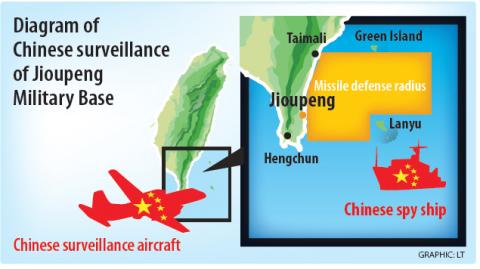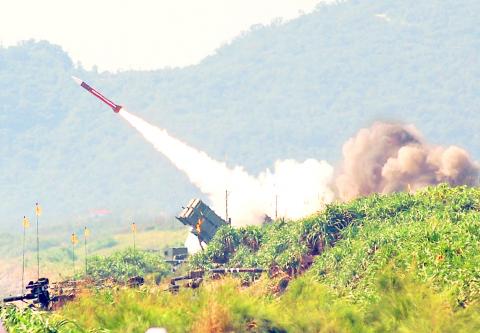China sent a surveillance ship and spy aircraft to waters and airspace near Taiwan’s to gather intelligence last week during missile and air defense drills at a military base in Pingtung County, Ministry of National Defense (MND) officials confirmed yesterday.
The officials said the Chinese People’s Liberation Army (PLA) used electronic surveillance to track missile testing at the highly restricted Jioupeng Military Base (九鵬基地) in southern Taiwan.
It came in the wake of reports that Chinese visitors were spying and taking photographs near the nation’s military bases and other sensitive facilities, some of whom were known to be PLA officers and agents posing as tourists.

The ministry monitored the Chinese ship and aircraft as they approached the nation during the two-day missile tests, it said in a statement yesterday.
“Our armed forces were fully aware of their activity and implemented countersurveillance and security measures,” the statement said. “We have surveillance systems for effective monitoring of the nation’s surrounding airspace and waters, and have contingency plans for the protection and security of our nation.”
The ministry was responding to a report published yesterday by the Liberty Times (sister newspaper of the Taipei Times) saying that the encroachment by Chinese spy vessels took place when Jioupeng Military Base was test-firing US-made MIM-104C (PAC-2) Patriot missiles on Wednesday and Thursday last week.

Photo: Tsai Tsung-hsien , Taipei Times
Quoting a source in the military, the report said a Chinese surveillance ship was picked up on radar on Wednesday morning about 60 nautical miles (111km) to the east of the base, which is in Pingtung’s mountainous region facing the Pacific Ocean.
On the next morning at the same time — when the Patriot missile system was scheduled for test firing — the radar station detected a Chinese spyplane approaching Taiwanese airspace.
After each detection, military officials immediately suspended the launch and shut down the system to prevent the Chinese vessels gathering intelligence, said the military source, who requested anonymity.

Photo: Hsu Shao-hsuan, Taipei Times
Ministry spokesman Major General David Lo (羅紹和) confirmed the radar detections last week.
“Our armed forces reacted quickly with effective countermeasures and suspended the missile tests at those times, which prevented the Chinese PLA surveillance vessels from achieving their intelligence-gathering goals,” Lo said.
The military was holding live-fire and air defense exercises with its combined forces at the base in the final two weeks of last month, starting with tests of Taiwan’s domestic Tien Kung I (Sky Bow I, 天弓) and other short-range, surface-to-air missiles on May 21 and 22, officials said.
These drills were followed in the subsequent week by air defense drills and the test launches of Tien Chien II (天劍 Sky Sword II), Patriot PAC-2 and other guided surface-to-air missiles, they added.

‘WIN-WIN’: The Philippines, and central and eastern European countries are important potential drone cooperation partners, Minister of Foreign Affairs Lin Chia-lung said Minister of Foreign Affairs Lin Chia-lung (林佳龍) in an interview published yesterday confirmed that there are joint ventures between Taiwan and Poland in the drone industry. Lin made the remark in an exclusive interview with the Chinese-language Liberty Times (the Taipei Times’ sister paper). The government-backed Taiwan Excellence Drone International Business Opportunities Alliance and the Polish Chamber of Unmanned Systems on Wednesday last week signed a memorandum of understanding in Poland to develop a “non-China” supply chain for drones and work together on key technologies. Asked if Taiwan prioritized Poland among central and eastern European countries in drone collaboration, Lin

The Chien Feng IV (勁蜂, Mighty Hornet) loitering munition is on track to enter flight tests next month in connection with potential adoption by Taiwanese and US armed forces, a government source said yesterday. The kamikaze drone, which boasts a range of 1,000km, debuted at the Taipei Aerospace and Defense Technology Exhibition in September, the official said on condition of anonymity. The Chungshan Institute of Science and Technology and US-based Kratos Defense jointly developed the platform by leveraging the engine and airframe of the latter’s MQM-178 Firejet target drone, they said. The uncrewed aerial vehicle is designed to utilize an artificial intelligence computer

Renewed border fighting between Thailand and Cambodia showed no signs of abating yesterday, leaving hundreds of thousands of displaced people in both countries living in strained conditions as more flooded into temporary shelters. Reporters on the Thai side of the border heard sounds of outgoing, indirect fire yesterday. About 400,000 people have been evacuated from affected areas in Thailand and about 700 schools closed while fighting was ongoing in four border provinces, said Thai Rear Admiral Surasant Kongsiri, a spokesman for the military. Cambodia evacuated more than 127,000 villagers and closed hundreds of schools, the Thai Ministry of Defense said. Thailand’s military announced that

CABINET APPROVAL: People seeking assisted reproduction must be assessed to determine whether they would be adequate parents, the planned changes say Proposed amendments to the Assisted Reproduction Act (人工生殖法) advanced yesterday by the Executive Yuan would grant married lesbian couples and single women access to legal assisted reproductive services. The proposed revisions are “based on the fundamental principle of respecting women’s reproductive autonomy,” Cabinet spokesperson Michelle Lee (李慧芝) quoted Vice Premier Cheng Li-chiun (鄭麗君), who presided over a Cabinet meeting earlier yesterday, as saying at the briefing. The draft amendment would be submitted to the legislature for review. The Ministry of Health and Welfare, which proposed the amendments, said that experts on children’s rights, gender equality, law and medicine attended cross-disciplinary meetings, adding that